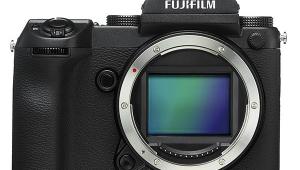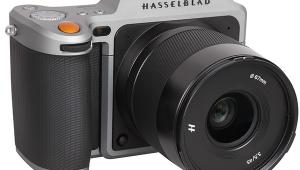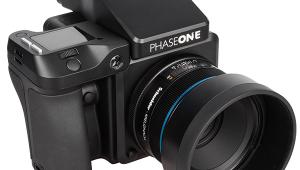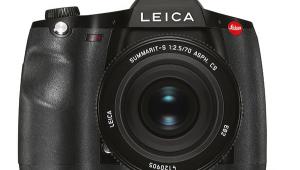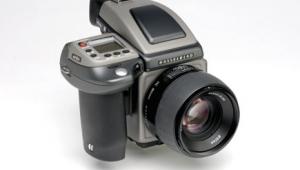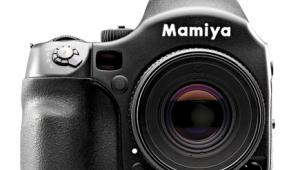Phase One XF IQ3 Medium Format Camera System Review

Since this is my first foray into camera reviews, I’ll start with a little background info. I am an automotive photographer on staff at two of Shutterbug’s sister publications, Motor Trend and Automobile. Prior to Motor Trend I managed Silvio’s Photoworks in SoCal, and before that I was a manager at the equipment and studio checkout at Brooks Institute of Photography, where I got my BFA. I have used everything from 4x5s to my iPhone, old or new, film or digital. And ever since my dad first handed me his Pentax K1000 in fifth grade, my lens has been aimed at cars.
So when I found out I would be evaluating Phase One’s new XF camera system, I knew I had to arrange a cool vehicle to shoot. The all-new Mercedes AMG GLE63 S is a 577-horsepower beast of an SUV, or coupe, or whatever you want to call it. It’s big, red, fast, weird, and more. Like it or hate it, people take notice. During my time with this snarling $100K monster several people gawked and asked questions. Like the Phase One, the AMG is overkill for most folks and just right for a few.

When requesting a camera from Phase One, I thought long and hard about my needs and what is most important to me, as a photographer, when it comes to image quality. If all-out detail is your game, or you suffer from a Napoleon complex, then the version for you is the big mama-jama IQ3 80MP. Megapixel count is a lesser part of the equation for me. And let’s face it, 80MP files sound awesome, until your company-provided laptop is chugging away in Photoshop trying to edit them. Instead I went with the new IQ3 50MP back, which sports the same Sony-built 50MP CMOS sensor that seems to be the flavor of choice in the medium format industry right now.
Cameras need lenses, and Schneider Kreuznach builds some beauts. So in addition to the XF, I borrowed the standard 80mm LS f/2.8, the 35mm LS f/3.5, and the bazooka-sized 75-150mm LS f/4.0-5.6. The crown jewel of this lineup is the all-new 35mm, which together with the new 120mm LS f/4.0 Macro (not tested during our loan) are, according to Schneider, “designed to resolve even beyond the limits of current sensor technology.”
My test shots of the Mercedes AMG GLE63 S with the Phase One system are included in this story. Pricing for the Phase One XF camera body, IQ3 50MP digital back, prism viewfinder, and Schneider Kreuznach 80mm LS lens “kit” is $40,990, making it almost half the cost of the Mercedes itself. Wow!

Build & Layout
The design of the Phase One XF camera system is minimalist perfection. Clean lines, few buttons, and a logical layout of controls. Ergonomics-wise it is a very comfortable medium format system to hold and use, and the material of the grips, wheels, and buttons feels appropriately rich and high quality.
Don’t get me wrong, the XF is a big camera, especially with some of the larger lenses attached, but good design and ergonomics make it feel smaller and manageable while you are using it. The XF also features a modular viewfinder design, allowing you to quickly swap between the standard 90-degree prism for a waist-level finder.
Instead of a multitude of buttons, the XF relies on two touchscreens and front and rear dials for most functions. The top screen, other than providing normal exposure information, allows you to change between the shooting, metering, and autofocus modes, as well as adjust exposure compensation, all by tapping the screen. ISO control gets its own dial on the back of the camera for quick adjustments and everything is very intuitive.
Although I didn’t know it at the time, you can lock the top screen once you make your changes, which is great because my Bigfoot-sized fingers kept accidentally changing shooting modes while reaching for the shutter button. A majority of Phase One XF users will likely be shooting tethered, so this won’t be a problem. But for “run and gun” automotive stuff, locking the screen is a must.
I spent most of my time on the rear screen. Other than reviewing images, you can double tap the screen to check focus at 100 percent or simply slide your finger up or down to zoom in or out of the image. Another incredibly useful feature is the ability to white balance anywhere in the image by using the eyedropper tool and tapping on a neutral part of the image. You can use the eyedropper function even while zoomed in and in live view mode. The live view function is also incredibly useful for manually focusing as you can zoom into the image and pan around to make sure everything is tack sharp.


Some Issues
Unfortunately, everything wasn’t all rainbows and unicorns. When using the white balance eyedropper while zoomed in, I had to be very careful when zooming back out of the image as it was easy to resample a different part of the image and end up with an incorrect white balance.
Also, on more than one occasion the back hiccupped and zoomed into an indicated 10,000 percent and froze. The only way I could figure out how to clear the problem was to shut down both the camera and back and restart. Normally this wouldn’t be an issue, but when you are waiting for the sun to get into just the right spot, and all of a sudden you need to switch everything off, it makes for a hectic 30 seconds!
All of those screens and electronic goodies eat up the battery quickly. The XF has two batteries, one in the IQ3 back and the other in the camera body. For the first time the systems share power between, meaning that when one goes dead—and it will—the other takes on the load. And, if you’re ever in a situation that warrants it, your assistant can hot swap the batteries without turning off the camera.

Performance
Now let’s get to the fun stuff. Instead of trying to accomplish a full-fledged editorial package of images as I would normally, I decided to focus on getting a few great images. Joining me on the adventure was my wife and fellow automotive photographer Jessica Walker. Together we decided to head north along the Eastern Sierras toward Bishop, California, and Mammoth Lakes. The eastern side of the Sierras has some of the most epic scenery in California and was the perfect place to utilize the XF’s and GLE’s strengths.
Dividing our time between shooting and driving, we spent a total of three days in the mountains. Every sunrise and sunset was spent putting the XF through its paces. We spent the hours with less favorable light scouting and exploring the area’s many lakes, towns, and back roads.
Initial start-up time on the XF takes a moment as both the camera body and IQ3 back come to life. This initial lag, although unusual to DSLR owners, is understandable due to the modular nature of medium format systems. Part of being a photographer is choosing the right tool for the job, and if lightning-fast start-up and response is high on your list, you may want to stick in the DSLR realm.
Once up and running, I was impressed by the focusing speed of the XF’s new Honeybee autofocus system. Aided by a focus assist light, which was so bright it put the headlights on the Mercedes to shame, the XF quickly and accurately acquired focus.
The problem, as with many medium format cameras, is that there is only one focusing point. This means unless your subject is filling a significant part of the frame, you can’t rely on it to provide sharp focus. Luckily focusing manually using live view is fairly quick and painless. I did attempt using the continuous shooting and focusing mode to shoot an action shot, with disastrous results.

Image Quality
Although smaller in dimension than the CCD found in Phase One’s IQ3 60MP (53.9x40.4mm) and 80MP (53.7x40.4mm) siblings, the IQ3 50MP (44x33mm) back enjoys a full stop more dynamic range and ISO capability, and still boasts a huge advantage over any 35mm-size sensor. Automobiles have huge tonal ranges from bright reflective headlights to dark rubber tires, and every bit of dynamic range is utilized to make the image feel balanced.
The amount of dynamic range the XF IQ3 system was able to capture in my test images was impressive. With 14 stops of dynamic range, each image capture contains enough latitude to balance shadow and highlight details with very smooth tonal gradations and very little shadow noise. The resolving power of the lenses, combined with the lack of an aliasing filter, meant the images came out tack sharp, with an overall richness.
Most of my time was spent shooting at ISO 100, which showed very little digital noise even in the deep shadows of the wheels and tires. For the interior shots we bumped it up to ISO 400 and there was a little bit of noise starting to rear its ugly face, but nothing atrocious and if you were not looking for it, it would probably go unnoticed. I never pushed the XF past ISO 400, but from what I have been told, the Sony sensor handles higher ISOs quite well.
Color rendition was fairly accurate and being able to spot color balance on the back of the screen gave me a reason to dust the cobwebs off of my color-checker chart. Even when shooting backlit with lots of flare from the falling sun, the Mercedes’ red exterior popped well, straight out of camera. The dynamic range helps in this regard as well, by allowing colors to gradate more smoothly and naturally.

Conclusion
The new Phase One XF is not a perfect camera. The touchscreens can be difficult to use and the IQ3 back did have some electrical gremlins. It’s also too slow, heavy, and lens-limited for the type of editorial automotive work I normally do. The XF is definitely aimed at the more controlled atmosphere of commercial, landscape, and portrait photographers. That said, the XF’s clean, minimal design is extremely well thought out and very comfortable to use. As you can surmise from the previous section, image quality out of the IQ3 50MP digital back and Schneider Kreuznach lenses was stellar and worlds beyond anything you’d get from a full-frame DSLR. With the XF IQ3 system, Phase One has taken the next big step in medium format photography.
- Log in or register to post comments


